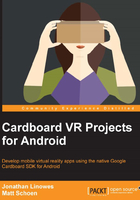
Cardware!
Let's take a look at the different Cardboard devices that are available. There's a lot of variety.
Obviously, the original Google design is actually made from cardboard. And manufacturers have followed suit, offering cardboard Cardboards directly to consumers—brands such as Unofficial Cardboard, DODOCase, and IAmCardboard were among the first.
Google provides the specifications and schematics free of charge (refer to https://www.google.com/get/cardboard/manufacturers/). For example, the Version 2.0 Viewer Body schematic is shown as follows:

The basic viewer design consists of an enclosure body, two lenses, and an input mechanism. The Works with Google Cardboard certification program indicates that a given viewer product meets the Google standards and works well with Cardboard apps.
The viewer enclosure may be constructed from any material: cardboard, plastic, foam, aluminum, and so on. It should be lightweight and do a pretty good job of blocking the ambient light.
The lenses (I/O 2015 Edition) are 34 mm diameter aspherical single lenses with an 80 degree circular FOV (field of view) and other specified parameters.
The input trigger ("clicker") can be one of several alternative mechanisms. The simplest is none, where the user must touch the smartphone screen directly with her finger to trigger a click. This may be inconvenient since the phone is sitting inside the viewer enclosure but it works. Plenty of viewers just include a hole to stick your finger inside. Alternatively, the original Cardboard utilized a small ring magnet attached to the outside of the viewer, held in place by an embedded circular magnet. The user can slide the ring magnet, and the change in magnetic field is sensed by the phone's magnetometer and recognized by the software as a "click". This design is not always reliable because the location of the magnetometer varies among phones. Also, using this method, it is harder to detect a "press and hold" interaction, which means that there is only one type of user input "event" to use within your application.
Cardboard Version 2.0 introduced a button input constructed from a conductive "strip" and "pillow" glued to a Cardboard-based "hammer," like the ones in a grand piano. When the button is pressed, the user's body charge is transferred onto the smartphone screen, as if he'd directly touched the screen with his finger. This clever solution avoids the unreliable magnetometer solution, and instead it uses the phone's native touchscreen input, albeit indirectly.
It is also worth mentioning at this point that, since your smartphone supports Bluetooth, it's possible to use a handheld Bluetooth controller with your Cardboard apps. This is not part of the Cardboard specifications and requires some extra configuration: the use of a third-party input handler or controller support built into the app. A mini Bluetooth controller is shown in the following image:

Cardboard viewers are not necessarily made out of cardboard. Plastic viewers can get relatively costly. While they are more sturdy than cardboard they fundamentally have the same design (assembled). Some devices allow you to adjust the distance from the lenses to the screen, and/or the distance between your eyes (IPD or inter-pupillary distance). The Zeiss VR One, Homido, and Sunnypeak devices were among the first to become popular.
Some manufacturers have gone outside the box (pun intended) with innovations that are not necessarily compliant with Google's specifications but provide capabilities beyond the Cardboard design. A notable example is the Wearality viewer (http://www.wearality.com/), which includes a patented 150-degree field of view (FOV) double Fresnel lens. It's so portable that it folds up like a pair of sunglasses. A pre-release version of the Wearality viewer is shown in the following image:
